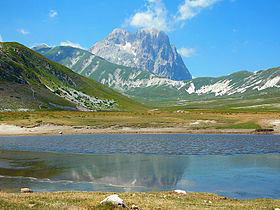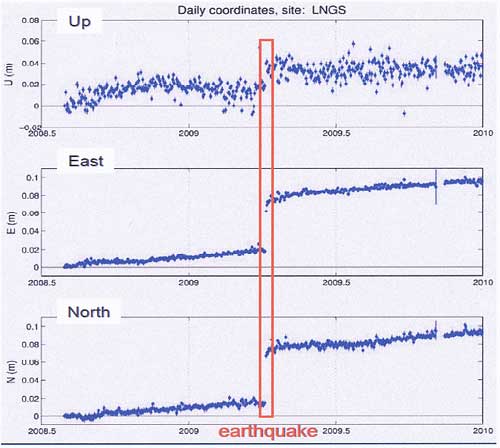Physicists
at Italy’s Gran Sasso neutrino detector, named “OPERA”, made a shocking
announcement last week: their regular deliveries of Swiss neutrinos
arrived too soon — — a 16th of a millionth of a second before Einstein
said was possible.
If correct, this would invalidate
several hallowed theories of physics and would conflict with previous
experiments that confirm Einstein.
The scientific world is aghast. Can
their measurements be correct? Will this revolutionize physics, or end
up as merely a fanciful Italian opera?
Since I’ve done neutrino experiments, I
was eager to understand what all the fuss was about. I found and read
the original scientific paper containing all the juicy details not
reported in the popular press. Here is what I found.
Like all neutrino experiments, OPERA is a
lavish production. Nearly 300 physicists from 50 institutions and a
dozen countries have contributed. The detecting target weighs 625 tons
and is located inside the largest mountain in the Apennines, Mt. Gran
Sasso, about 80 miles from Rome. A picturesque image of Gran Sasso is
shown below.

A six-mile long tunnel was bored through
the mountain for a freeway and to provide a place for OPERA, below
nearly one mile of solid rock, thus shielding it from cosmic rays.
The
source of neutrinos for OPERA is an older proton accelerator at CERN,
the major European physics lab located 430 miles away near Geneva,
Switzerland. There, over a mile of tunnels were dug for the apparatus
that produces a high-energy beam of neutrinos aimed precisely at OPERA.
The neutrinos hardly notice passing through hundreds of miles of
bedrock. Over 30 months, 100 billion, billion protons at CERN produced
16,000 detected neutrinos at Gran Sasso. An artist’s sketch of the
neutrino source at CERN is shown below.

In 1905, Einstein declared that nothing can travel through space faster than c,
the speed of light in empty space, which is 671 million mph in American
units, or as I like to say, one foot per nanosecond (a nanosecond,
“ns”, is one billionth of a second). Since 1905, tens of thousands of
experiments have tested Einstein's statement to extraordinary precision.
While a few claimed to prove Albert wrong, no such claim held up under
scrutiny. Einstein’s theories have been confirmed to the limits of our
best instruments, in some cases one part in a billion, billion (18
decimal digits). In addition, our theories predict a variety of
absurdities if anything really can go faster than c.
When shocking claims are made,
physicists (like everyone else) demand compelling proof. We are less
than impressed when extraordinary claims are based on complex,
convoluted arguments or data that must be extensively “massaged.”
Speed is generally easy to determine—one
divides the distance traveled by the transit time. Ideally, to prove
that something traveled faster than c, we
would observe that thing move across a precisely measured distance in a
precisely measured time. That is NOT what we have here.
This experiment measured where and when
neutrinos arrived, but did not directly observe where and when any one
of these neutrinos was produced. Additionally, measuring the distance
and transit times is complicated by the fact that both the source and
detector are deep below ground. The OPERA physicists made great efforts
to overcome these limitations, and have seemingly done a professional
job. But the measurements contain a lot of “black boxes” and data
massaging, which present opportunities for error.
One might think that with hundreds of
physicists involved no mistake should go unnoticed. But as someone with
similar experiences, I can imagine a lot of chaos with hundreds of
strong egos, from scores of universities and a dozen countries, speaking
a multitude of languages. Is there any one person who understands
everything and can ensure all the pieces fit together as they should?
OPERA
was not designed to measure neutrino speeds, but to study how certain
neutrinos evolve during their journey from the Alps to the Apennines.
When the group first attempted to measure neutrinos’ speed, their
initial result was that the neutrinos arrived 1049 ns too soon—their
flight time from CERN to Gran Sasso was 1049 ns less than the time light
would take to make the same trip, making the neutrinos’ speed 1.001 c.
Over
several years, they carefully re-measured their distances and
re-calibrated their clocks. They then made six “corrections” to their
first result: three corrections added a total of 1386 ns to the transit
time, while the other three corrections subtracted a total of 398 ns.
Overall, the result decreased by a factor of 16. Fifteen “black boxes”
and a GPS satellite are used to synchronize clocks at the two sites; one
box has a delay of 41,000 ns. Even a minor misunderstanding of any of
these devices could drastically alter the result.
Below is a plot of OPERA’s measured
location—clearly evident are the gradual tectonic plate drift and a
sudden shift of 3 inches during an earthquake in 2009.

After making all these corrections,
OPERA’s final result is that neutrinos arrive from CERN 61 ns before
light would arrive, with an estimated precision of ±10 ns. This makes
their speed 1.000,025 c ±3 in the last digit.
An earlier measurement by several
groups, comparing the arrival times of neutrinos and light from
supernova SN1987a, concluded that the speed of those neutrinos equaled c
to two parts in a billion. That result is 1000 times more precise than
OPERA's, but a lower energy.
Considering the intricacy of the problem
and the importance of the result, the jury will likely remain out on
OPERA until other groups perform similar experiments.
Best Regards,
Robert
Sept 26th, 2011
|